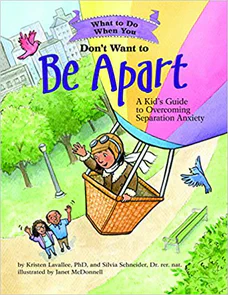What to Do When You Don’t Want to Be Apart
A Kid’s Guide to Overcoming Separation Anxiety
Written by Kristen Lavalee, Ph.D. and Dr. Silvia Schneider
Illustrated by Janet McDonnell
88 pages
•
Published 2017 (Magination Press)

Recommended Age Range: Kindergarten through 5th grade.
Publisher's Summary:
Flying a hot air balloon sounds like a lot of fun to some kids. But for other kids, the idea of flying off on their own, away from their parents or homes, doesn’t sound like fun at all. If you feel scared when you do something alone or away from your parents, this book is for you! What to Do When You Don’t Want to Be Apart guides children and their parents through the emotions underlying separation anxiety using strategies and techniques based on cognitive-behavioral principles. This interactive self-help book is the complete resource for educating, motivating, and empowering children to overcome separation anxiety — so they can become the confident pilots of their very own hot air balloons!

Dr. Annie's Takeaways
Recommended for: Children who are ready to be more independent and less bothered by their separation anxiety will likely find this workbook to be helpful and non-judgmental. It’s not the most fun book, but it lays out a clear path to being able to enjoy birthday parties and tolerate nights with babysitters, which will be a relief to many children bothered by separation anxiety. Children who aren’t yet self-motivated to practice coping with separations may or may not be engaged enough by the metaphor of flying a hot air balloon to get on board with the activities presented. That said, it is a collection of the most effective Cognitive Behavioral Therapy
tools for reducing separation anxiety, so it could be useful for a caregiver to read even if a child isn’t quite ready for it. Therapists may also find this book helpful to use during therapy sessions and/or as between-session homework for caregivers and children to complete each week.
Would a child like it? A child who is sick of feeling anxious when separated from their caregivers will appreciate this book and the concrete strategies it provides for reducing anxiety. It’s best read in small sections, even with a child who is ready to conquer this fear. A child who is more ambivalent about their anxiety might not like it. But they might still benefit from working through it with someone they trust.
Tone: Reassuring, informative, encouraging.
Story Quality: This workbook uses the metaphor of a child learning to fly a hot air balloon to motivate a child to get excited about building independence and an ability to “steer [their] own balloon.” “Flying solo means piloting your own hot air balloon, while away from your parents or home.” The metaphor is moderately fun, although I’m not sure how many children have thought much about what it would be like to pilot a hot air balloon. The explanations for the different activities in the book are clear and would likely be fairly convincing to many children.
Illustrations: Black-and-white watercolor illustrations that supplement the text. Most pages have an illustration, but some pages are dominated by text.
Representation: At the beginning of the workbook it states that “in this book, we will refer to ‘parents’ or your ‘mom or dad.’ However, not every family looks the same–you might live with a mom, a dad, or both parents. You might have two moms or two dads. You might live with step-parents, grandparents, foster parents, or other caregivers.” Many different children are portrayed in the illustrations throughout the text (i.e., children with different skin tones, and genders; there is a child who uses a wheelchair, a mom in a hijab, and a boy in a yamaka).
Psychological Practices: This book provides psychoeducation about anxiety and separation anxiety, including anxious thoughts and physical feelings; introduces the connection between thoughts, feelings, and actions; teaches kids to identify “unhelpful thoughts” and challenge them with “realistic thoughts” and “uplifting thoughts”; helps kids recognize behaviors that are holding them back (e.g,. “Ask their teacher to call their mom every five minutes”; “yell or shout at their dad not not leave”) and how they can replace these behaviors with “helpful actions” such as taking deep breaths, playing a favorite game, squeezing muscles and relaxing them, exercising, or cuddling with pets; and provides a rationale and “flight plan” for exposure (i.e., “the more time you spend practicing something that makes you nervous (like riding a bike) the more likely you are to get used to it, and the more likely the anxiety is to go down”).
Concerns: None
